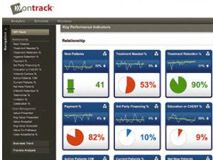How to increase your dental practice's ROI with the help of tracking software

Establishing profitability is the goal for most businesses, and it’s no different for dental offices. It’s pretty easy to see if a practice is making a profit, but it can be harder to identify the reasons why a practice is profitable in the first place.
Profitability can be affected by many different variables anything from where a practice is located, to what a practice’s hours are, and even the type of dental work a practice focuses on. With all of these different variables, tracking software is becoming an integral part of dental offices due to real time insights about how a practice is performing.
I often like to compare tracking software to a GPS. The first step is to choose your destination, or the areas where your practice can improve. Tracking software can then begin calculating, using your practice’s benchmarks, how to get to your destination. Finally, the software can tell you the best way to travel by giving quick tips along the way for how to modify your behavior. And, if in the middle of your trip, you decide you want to take a different route, you can simply change the destination and it will begin calculating your new route.
If you’re trying to get a handle on areas where you’re profiting and areas that could be improved to increase profitability, I believe there are three over-arching benefits that tracking software can offer to all practices:
Choose the areas your practice can improve: Even the most profitable practices in the world have room for improvement. Many tracking software packages allow practitioners to choose the areas they want to focus on improving and track metrics specific to those areas, with options ranging from customer service to case acceptance. By taking advantage of tracking software and using it correctly, practices can improve almost all areas of their business.
Set individualized benchmarks: It’s great to see how many patients said yes to a treatment or the percentage that paid while still in the office, but numbers don’t really mean anything unless you can compare them to another set of data. Typically, a practice will compare its metrics to industry benchmarks but that doesn’t tell the whole picture, making it difficult to find the real meaning for your practice.
By using tracking software, your practice can create its own set of internal benchmarks, which are the best indicators of individualized improvement. When you can compare your metrics over time and see growth personalized to you, you can begin to see how valuable tracking software can be, even if you’re numbers vary from industry benchmarks.
Help modify employee behavior: When you start to see where improvements can be made, the next logical step is to change your behavior to make these improvements. This is where tracking software can have the biggest impact on a practice. Throughout a patient interaction, the software will “prompt” dental staff to do certain actions, like schedule the patient for a hygiene appointment or check if he or she paid at the time of the appointment. With these quick reminders, your practice can begin to improve in specified areas.
Tracking software can be a scary topic for many dental practices because it points out the areas that need improvement. Don’t be scared. When used properly, this software will have you on your way to increased profits and a more efficient dental practice.
Note: This article is sponsored by Patterson Dental as part of the Dental Practice Management Partner Voice Program, which provides a way for leading dental manufacturers to share quality content with our audience. Patterson Dental offers a wide range of dental products including Eaglesoft Practice Management Software, CAESY Patient Education Systems and the RevenueWell marketing communications suite, which are backed by the renowned support and customer service team at the Patterson Technology Center. With multiple support options and more than 125 years experience in the dental industry, Patterson has the resources and expertise to help customers and practices reach their greatest potential.